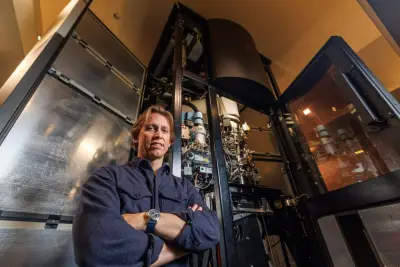A 10-foot microscope reveals big lessons about the tiniest threats to the human body

There s a technological revolution underway that s making it faster and easier for scientists to see the molecules that undermine human healthcare and possibly fight the difficulty The resolution revolution involves cryo-electron microscopes whose ever-improving detectors and solution are producing three-dimensional images in unprecedented detail aiding drugmakers They reveal detail so precise that biologist Andrew Ward of Scripps Research in La Jolla California was able to spotlight the Achilles heel of several types of coronaviruses in images that he produced in - Related Articles Lilly star weight-loss drug Zepbound faces coverage challenge from CVS Robustness Trump s wellness agency urges therapy for transgender youth not broader gender-affirming wellness care What s that rash Put various thought into asking Google for diagnostic help Medicaid cuts may disproportionately affect Black Latino doctors and their patients UMN vaccine initiative announces steering committee members The weaknesses he called out Spike proteins the now-familiar elements that allow such viruses to infect cells This helped drugmakers to know exactly what to target when SARS-CoV- the coronavirus that causes COVID- emerged in late Ward produced an even clearer snapshot of the proteins in further helping scientists create vaccines With additional help from him effective vaccines were briskly produced That was just the beginning disclosed Ward Now this tool is opening doors that help us understand the roots of diseases like cancer and neurodegeneration including Alzheimer s It routinely lets us see life s tiniest machines proteins viruses and the atoms they combine with breathtaking clarity he added The research isn t widely known to the population partly because it s hard to conceive of how any microscope let alone one that s feet tall can flash-freeze moving molecules exposing their structure and purpose Ward offered a simple analogy to explain the matter Imagine walking into a dark room he declared You can roughly tell where the furniture is and see shadowy outlines of a couch or a table But once the lights are on you can visualize color texture size and fine details That s what cryo-electron microscopes do and with great speed Ward could only produce about images per day when he was earning his doctorate at Scripps from to when he was using a far less powerful type of cryo-electron microscope And he had access to it only a day or two each month This day he can generate images per second on Titan Krios the largest and greater part powerful of Scripps seven cryo-electron microscopes If you were able to stack up the images he takes during a six-hour period they would rise as high as Mount Everest announced Ward who has been collaborating with institutes on SARS-CoV- Lassa HIV malaria and the H N bird flu Lab manager Hannah Turner shows the Titan Krios electron microscope at Scripps Research Institute in La Jolla California on Friday April Hayne Palmour IV For The San Diego Union-Tribune To the unfamiliar eye the images look bizarre Particular resemble bumpy frozen lava others crinkly Christmas wreaths Still others look like the knotty cords on old landline telephones But their importance is understood by scientists especially those focused on preparing the world for whatever pandemic could come next It s a bit of a fluke that Ward is a rising star at an institute that has helped develop more than FDA-approved drugs and treatments including Humira which is used by people who suffer from arthritis He was interested in science growing up outside Boston less so when he entered Duke University as a freshman Things promptly changed when he took a work-study job in a campus lab where cell biologists Michael and Mary Reedy let him tinker Before long Ward was helping build the components of microscope cameras and detectors and was dazzled by what they could do I began to see molecules and atoms commented Ward now It kind of blows your mind to follow things at that resolution Electron microscopes have existed since the s and they ve played a vital role in revealing the structure of proteins and viruses and how they work But the instruments didn t start to enter their current golden age until roughly the year Ward arrived at Scripps as a lab technician The advancements have come especially rapidly over the past decade starkly improving image resolution and enabling scientists to see individual atoms System has also made it easier to see molecules interact with prospective drugs helping determine which ones should go on to large-scale clinical trials The boom locally and worldwide didn t go unnoticed In three European scientists won the Nobel Prize in chemistry for helping transform cryo-electron microscopes into indispensable tools to explore the life sciences Ward says he s happy to be in the background But he has emerged as a leader in the field mostly through his use of Titan Krios Big Daddy as Ward calls it is highly sensitive The towering microscope sits on stabilizers to prevent something as simple as a slammed door from producing vibrations that could mess up image-taking It operates in silence for the same reason Lab manager Hannah Turner holds grids a single one used to hold a sample placed into the Titan Krios electron microscope at Scripps Research Institute in La Jolla California on Friday April Hayne Palmour IV For The San Diego Union-Tribune In plain terms the microscope freezes biological samples then hits them with electron beams that create images Once you see the arrangement of atoms the connectivity of molecules you can become an engineer Ward explained You can move things around and manipulate the building blocks of life to make new therapeutics and vaccines that have much higher likelihood of success compared to engineering without blueprints We ve sped up the process of choosing which one should be a go or no-go for clinical trials Ward noted That doesn t mean scientists are close to flooding the realm with new means of prevention The foreseen vaccines will collectively have to go through five to seven years of trials in humans he added But we are no longer shooting in the dark or relying on empiricism We can now shine a light or rather a very powerful electron beam on the science driving vaccine research


